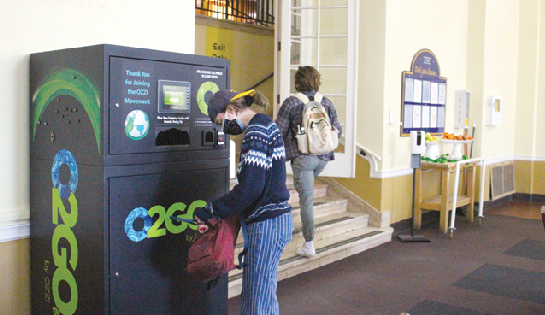Green boxes return after year-long hiatus

Student returns green box in Brooks Dining Hall.
Through the combined efforts of the Allegheny Student Government and Parkhurst Dining, green boxes are once again available for use in Brooks Dining Hall. Their return was hailed by “Green Box Revival Week,” in which members of ASG and Students for Environmental Action hosted tabling events in the Brooks foyer to inform students about the returning program and give away sustainable prizes.
ASG Director of Sustainability and Environmental Affairs Willy Walker, ’22, expressed his delight with the student response to the programming.
“I think (green box revival week) was a success,” Walker said. “This is the most I think I’ve ever seen green boxes being used ever. I didn’t expect them to be used in quite this much capacity, especially with some of the uncertainty with COVID. (The Allegheny College Health Agency) obviously cleared it or else we wouldn’t have even thought of putting them back in, but I know some students have a little bit of cold feet with that.”
Director of Sustainability Kelly Boulton, ’02, elaborated on the initial concerns students and ACHA members had with the green box program.
“What made (green boxes) go away last semester was entirely concerns about surface transmission,” Boulton said. “When we were making the decisions in the summer and the early fall, the (Center for Disease Control and Prevention) was still advising that we disinfect all surfaces and we had two concerns. One, we didn’t want a Parkhurst employee touching a box and handing it to a student because there could be surface transmission there, even though Parkhurst is super careful about cleanliness and wearing gloves. But then the reverse is also true. If students are returning boxes, the Parkhurst employee that has to open that up, empty it out and wash that. We didn’t want that to become a point of transmission either because it’s not fair to employees.”
Although the CDC declared surface transmission to be lower risk, changes are better received by the student body at the beginning of a semester, especially when students are adapting to daily COVID-19 updates and changes, according to Boulton.
Boulton explained the importance of the green box program to Alleghey’s sustainability goals.
“We’ve been working to build up the green box program for years now,” Boulton said. “When students use it regularly, it has the potential to prevent 14 full fillings of Mellon pool every year. I think the nature of single use waste is that we use it, throw it away and it’s gone from our conscience. It’s gone from our physical space. So we never stopped to recognize how this culture that we’ve been brought up in — which is very single use and disposable — builds up into this significant amount of waste. If we could see that amount of waste, we would have a lot more reason to change our habits.”
Sebastian McRae, ’22, a member of SEA and a participant in green box revival week’s tabling efforts, expressed concerns similar to Boulton’s, especially in the context of Brooks.
“Right now, it’s important to use green boxes because the current containers in Brooks aren’t compostable,” McRae said. “These ones are plastic lined paper.”
McRae further explained that even without the plastic lining, single use boxes like those currently in Brooks are not ideal.
“Making paper is very inefficient,” McRae said. “It requires a lot of energy, and when it’s not disposed of properly, it ends up in landfills and produces methane, which turns into carbon dioxide when burned.”
Boulton explained that green boxes will ultimately see a return to McKinley’s at some point in the future, but not before the end of this semester.
“(Walker) and I talked with them about if we could include something on the GET app that says, ‘do you want your food in a green box,’ but they were having issues with the app to begin with and we didn’t want to add another complicating factor,” Boulton said. “So our understanding is that for this semester, it’s not available in McKinley’s.”
Boulton and Walker both acknowledged that the ever-changing state of Brooks has been a cause for confusion among students.
“A student asked me yesterday, ‘how do we use the green box program if you’re doing the pick four option in Brooks?’” Boulton said. “I’m not an expert on Brooks because I don’t eat there, but I consulted with my students and they told me that when you go to the first station, you ask for your food in a green box. So you get your green box in that first transaction … and then you can go to the other stations and ask them to put your food in it.”
Green Box Revival Week was seen by organizers as a way to re-establish sustainability efforts as a goal of the student body.
“The class of 2024 never had these,” Walker said. “They had very little information about green boxes to go off of. The class of 2023 had them for about a semester and a half, so there was still that fresh, new-to-college feel. And then, for ’21 and ’22, that was very much a re-learning process.”
Kristen Cadham, ’24, echoed Walker’s sentiment.
“The primary goal (of Green Box Revival Week) was to increase usage of the boxes,” Cadham said. “But even if not everyone uses them, at least we get the chance to educate them about sustainability.”
With Green Box Revival Week now behind them, Walker said he and Boulton are continuing work on yet-to-be-revealed projects. Although they primarily focused on the use of green boxes, Boulton suggested that students look beyond the program to continue increasing both their personal and the college’s sustainability.
“The green box program is great and it has a huge potential to reduce our waste, but the biggest deciding facto0r on how effective the program is and how much waste we reduce is student interaction with it,” Boulton said. “If you care about minimizing your waste, if you care about sustainability and climate action and climate justice, we need students to use this program. The green boxes are great, but carry a reusable utensil, carry a reusable cup, because just using the green box will only reduce half of your waste.”

Roman Hladio is a senior from Wexford, Pennsylvania. He is studying English with a creative writing emphasis, and completing requirements for a Journalism...

Sami Mirza is a senior from many different places. He is majoring in International Studies with a focus on the Middle East and North Africa and minor in...








